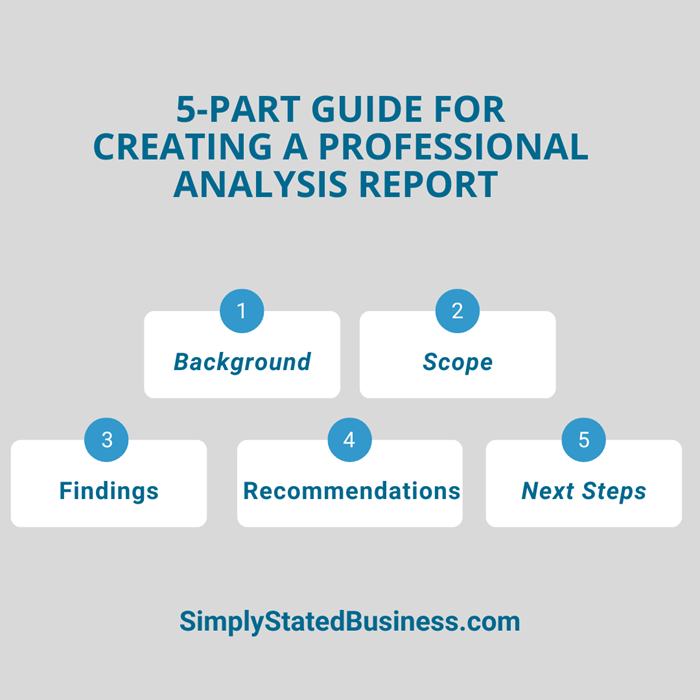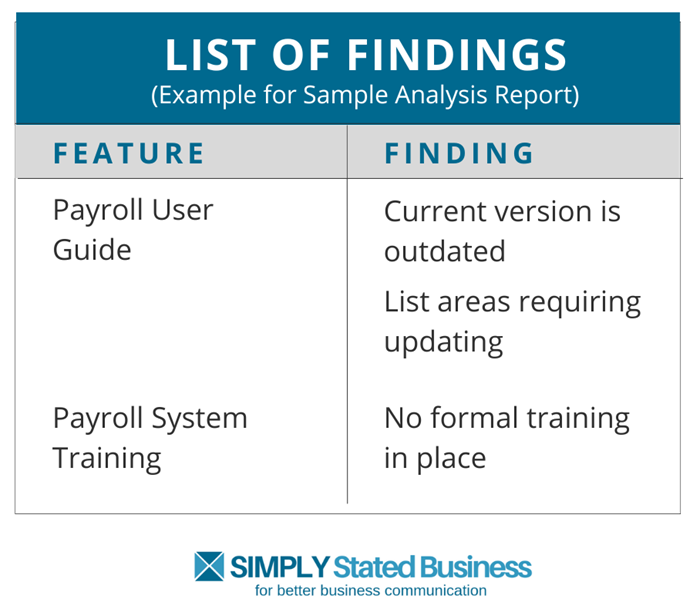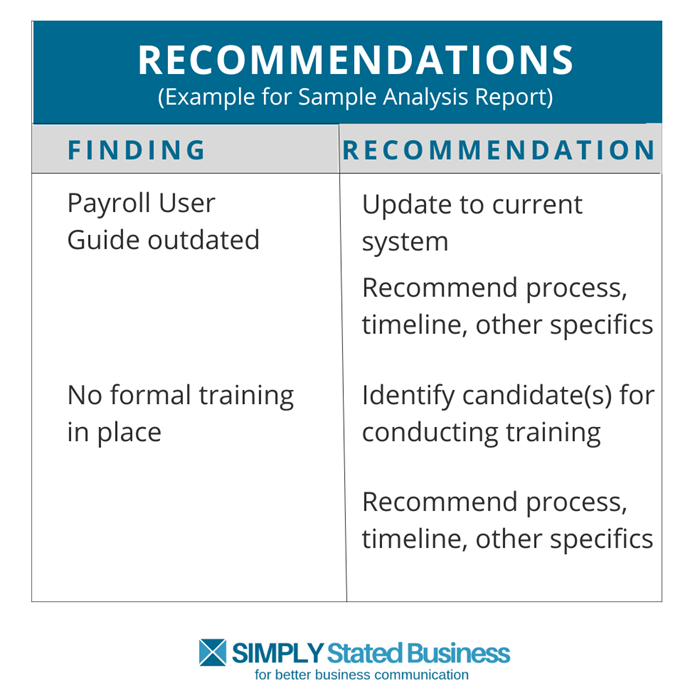 Have you panicked when a client asked for a professional analysis report? No matter what your business, eventually someone asks you to analyze something.
Have you panicked when a client asked for a professional analysis report? No matter what your business, eventually someone asks you to analyze something.
- Designers analyze websites.
- Writers review communication.
- Specialists consult on their niche.
It is especially daunting if you’re not a professional writer. Can you pull off something off that knocks the socks off prospects and clients?
Yes, you can.
What is a Professional Analysis Report?
A professional analysis report gathers information, analyzes what you discovered, and presents ideas for the best approach to a problem.
The reason for an analysis report (or analytical report) varies.
- A business may come to you with a problem and ask for a solution.
- Or you approach the business with a proposal for a new product or service.
The report provides a tool for decision-makers so they are well-informed on the best course of action.
You know your job. So even if you are not a writer, you have the expertise you need for an analysis report. And it offers you a golden opportunity.
- A written report shows thought.
- It lends credibility to your analysis.
- The report establishes your professionalism.
Report Template
Don’t know where to start? Follow this simple 5-part guide that helps even non-writers shine. You can also download the Report Analysis Template to help you develop your report.

1. Report Background
Think of the background as the foundation of your report.
It tells the reader why you are doing the report and what you want to achieve with the report. Below is a scenario used to create a sample background.
- You are the owner of Genius Consulting firm.
- Your business helps companies with payroll systems.
- Mary HR asked you for an analysis of her company’s (Better Manufacturing) system.
Now, weave those elements into the report Background.
Sample Background
Better Manufacturing hired Genius Consulting for an assessment of its current payroll system. [Insert details about the current system – e.g., type/version of software, functions, capabilities, etc.)].
The objective of this analysis is to assess the payroll software needs of Better Manufacturing, evaluate the effectiveness of the current payroll system, and to make recommendations based on Genius Consulting’s findings.
Why do you want a background section?
- The background provides information to a reader unfamiliar with Mary HR’s request.
- It ensures everyone is on the same page in terms of objective.
2. Scope of Analysis
The Scope of Analysis defines what you analyzed and how.
Payroll systems may be part of a larger human resource (HR) management system. The following are examples of subjects addressed in your Scope of Analysis.
- Review of payroll system user guide
- Onsite testing of payroll system
- Analysis of interface with HR management system
- Evaluation of technical support organization
The more specific you are, the better the understanding of the focus of the analysis.
3. Findings
The Findings section is the showcase for your expertise. Show ‘em what you got. 😊
- Identify the problem.
- Describe the impact.
The following are a few options for formatting your findings. It’s not a complete list. Do what makes sense and best conveys your findings.
- Use headings, text and lists to differentiate findings.
- Incorporate a number system for findings.
- Summarize findings with a table list
The use of headings, text, and lists works much like the formatting you use to make your content easy to read and scannable.
The following offers examples of the use of numbers to identify findings, or as an alternative, a table list.
Example #1 – Number System
Finding #1 – User guide needs updating
Since the initial installation of the payroll system, multiple system changes occurred. The payroll user guide is outdated and does not reflect current operation. [Insert areas requiring updates and describe impact of the problem.]
Finding #2 – There is no formal training program in place.
Explain finding and impact.
Example #2 – Table List
The table list provides a snapshot of your findings. You may want to consider combining it with a more detailed explanation.

4. Recommendations
Recommendations reflect your understanding of the issues and your client’s needs.
Here are areas to consider in developing recommendations.
- Impact on staffing, budget
- Feasibility – how likely is it to happen?
- Are there other options?
- What is the desired outcome?
For easier reading and comprehension, consider the following formats.
- Recommendations numbered to match findings
- Side-by-side table comparison of findings and recommendations
Example #1 – Number System
Recommendation #1 – Update User Guide
Provide recommended process, timeline, and other specifics.
Example #2 – Table Comparison

5. Next Steps
A Next Steps section evokes a response.
Have you ever spent extensive time conducting analysis only to have your efforts go nowhere?
A Next Steps section won’t guarantee that won’t happen, but it encourages some form of response.
The following are examples of Next Steps issues.
- Identify action items for follow-up.
- Develop timeline for implementation.
- Assign resources.
- Establish budget.
The Finished Product
Use the 5-part template for developing a professional representation of what you do best – finding solutions for your clients’ problems.
- Background – lay out the foundation for your report.
- Scope of Analysis – define what you analyzed and how.
- Findings – showcase your expertise by identifying problems and the impact.
- Recommendations – show you understand what your client needs.
- Next Steps – help your client make it happen.
An optional section of an analysis report is an Executive Summary. In my next post, I’ll share ideas for developing an effective Executive Summary.
What do you include in your analysis report?
==================================
Note: This post originally published on May 7, 2012. This October 21, 2022 version updates it.
===================================

Just suggested to a client that he hire me to do such a report and we also do a press release on it. Thanks
Now that’s a smart client to hire you, Anne. 😉
What a fantastic outline, Cathy. It’s a template anyone can follow.
Thank you, Sharon. I appreciate that. 🙂
Perhaps because we are more technical in our efforts (even with forensic accounting), we don’t employ recommendations and next steps. We do use Findings or Results. Instead of recommendations, we have discussion and analysis.
Our executive summary is the place for our summary AND always includes steps the client entity needs to effect to insure the results for which they paid provide the desired benefit(s).
Hi Roy: Thanks for sharing your approach. Each business adjusts to their own needs and the type of report they produce. Some are going to be more comprehensive than others. As long as it has good structure & flow, the format can be of your own choosing.
I often adjust the style for the circumstances. Again, thanks for sharing a different approach, Roy.
When one understands the purpose of a report and has a template guide as above, it becomes easier to analyze anything. I have often tailored reports to the clients needs
That’s a good practice, Roberta. 🙂 Thanks for stopping by.